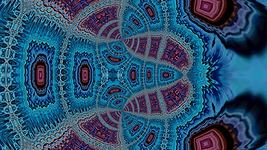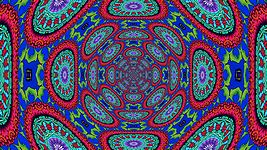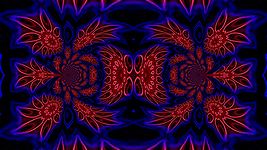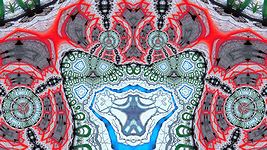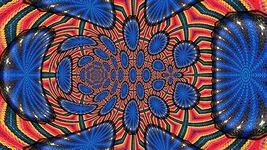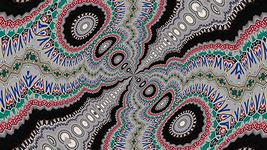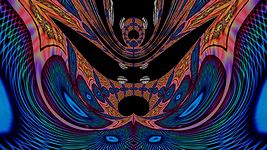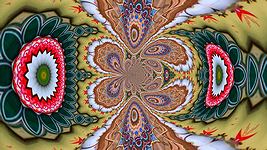Kaleider Mapping

 The Mapping feature applies effect Tiles along the contours of complex
variable functions. It uses a variation of Phase Plotting, which is a
technique for visualizing complex funtions. A complex number is composed of both
real and 'imaginary' parts, commonly represented in the form z = a + bi,
where a is the real value and b is the imaginary value
(i is the square root of -1). The Maps Menu provides a
selection of Complex Variable Functions in terms of the complex variable
z. Click the
The Mapping feature applies effect Tiles along the contours of complex
variable functions. It uses a variation of Phase Plotting, which is a
technique for visualizing complex funtions. A complex number is composed of both
real and 'imaginary' parts, commonly represented in the form z = a + bi,
where a is the real value and b is the imaginary value
(i is the square root of -1). The Maps Menu provides a
selection of Complex Variable Functions in terms of the complex variable
z. Click the  button on Kaleid Tools
(or type the F12 key) to toggle Mapping on/off. Right-click
button on Kaleid Tools
(or type the F12 key) to toggle Mapping on/off. Right-click
 to access the Maps Menu.
to access the Maps Menu.
Mapped scenes will continually change as Kaleider activity occurs,
such as while manually shifting effects, or with automated Wandering motion,
or during Automatic Effects. The
Quality Control screen can be used
to specify a default Quality Level for Maps. There are also
options to temporarily use lower Quality Levels during continuous activity.
 Click Mapping Options on the Maps Menu to
control additional Mapping capabilities. Set Allow Shifting Mapped
Effects to show Tile motions in the Mapped scene (when Center
is off). Otherwise, Mapped Tiles will remain stationary (as when
Center is on). Similarly, Tile Scaling can be expressed in
Maps when the Allow Scaling Mapped Effects option is set. It's
also possible to show Rooms and/or Surfaces in Maps by setting the
Map Room Scenes and/or Map Non-Flat Surfaces options. Maps
can optionally be used within Pattern Combo Areas as specified during the
Combo Design process.
Click Mapping Options on the Maps Menu to
control additional Mapping capabilities. Set Allow Shifting Mapped
Effects to show Tile motions in the Mapped scene (when Center
is off). Otherwise, Mapped Tiles will remain stationary (as when
Center is on). Similarly, Tile Scaling can be expressed in
Maps when the Allow Scaling Mapped Effects option is set. It's
also possible to show Rooms and/or Surfaces in Maps by setting the
Map Room Scenes and/or Map Non-Flat Surfaces options. Maps
can optionally be used within Pattern Combo Areas as specified during the
Combo Design process.
Mapping activity is recorded with Scripts, and the captured Mapping Actions
can potentially be altered via the Script Control and Editing screen.
Mapping can optionally be included with Automatic Effects. Use
the Maps tab of the Configuration
screen to control how often Mapping should be applied, and which Map
Functions are available for random selection.

 The Mapping feature applies effect Tiles along the contours of complex
variable functions. It uses a variation of Phase Plotting, which is a
technique for visualizing complex funtions. A complex number is composed of both
real and 'imaginary' parts, commonly represented in the form z = a + bi,
where a is the real value and b is the imaginary value
(i is the square root of -1). The Maps Menu provides a
selection of Complex Variable Functions in terms of the complex variable
z. Click the
The Mapping feature applies effect Tiles along the contours of complex
variable functions. It uses a variation of Phase Plotting, which is a
technique for visualizing complex funtions. A complex number is composed of both
real and 'imaginary' parts, commonly represented in the form z = a + bi,
where a is the real value and b is the imaginary value
(i is the square root of -1). The Maps Menu provides a
selection of Complex Variable Functions in terms of the complex variable
z. Click the  button on Kaleid Tools
(or type the F12 key) to toggle Mapping on/off. Right-click
button on Kaleid Tools
(or type the F12 key) to toggle Mapping on/off. Right-click
 to access the Maps Menu.
to access the Maps Menu.
 Click Mapping Options on the Maps Menu to
control additional Mapping capabilities. Set Allow Shifting Mapped
Effects to show Tile motions in the Mapped scene (when Center
is off). Otherwise, Mapped Tiles will remain stationary (as when
Center is on). Similarly, Tile Scaling can be expressed in
Maps when the Allow Scaling Mapped Effects option is set. It's
also possible to show Rooms and/or Surfaces in Maps by setting the
Map Room Scenes and/or Map Non-Flat Surfaces options. Maps
can optionally be used within Pattern Combo Areas as specified during the
Click Mapping Options on the Maps Menu to
control additional Mapping capabilities. Set Allow Shifting Mapped
Effects to show Tile motions in the Mapped scene (when Center
is off). Otherwise, Mapped Tiles will remain stationary (as when
Center is on). Similarly, Tile Scaling can be expressed in
Maps when the Allow Scaling Mapped Effects option is set. It's
also possible to show Rooms and/or Surfaces in Maps by setting the
Map Room Scenes and/or Map Non-Flat Surfaces options. Maps
can optionally be used within Pattern Combo Areas as specified during the
